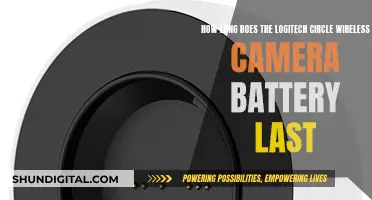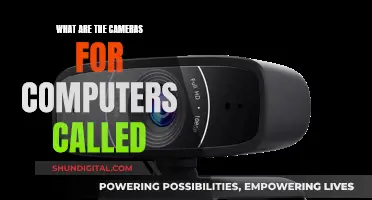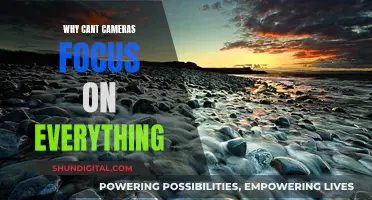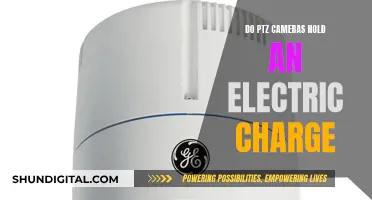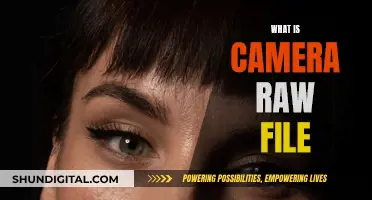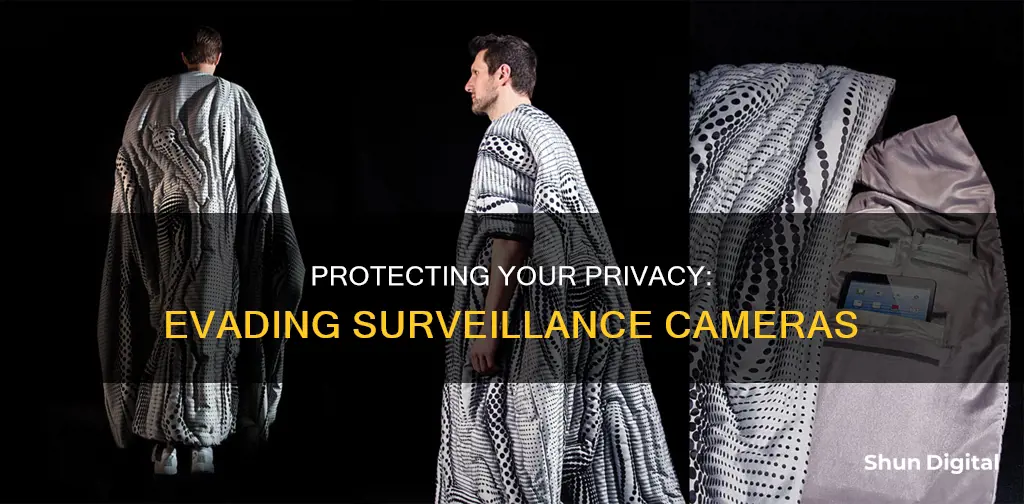
With the advancement of technology, surveillance cameras are becoming increasingly sophisticated and harder to detect or avoid. While these cameras can be used for legitimate purposes such as home security or crime prevention, they can also raise concerns about privacy and unauthorized surveillance. To protect yourself from surveillance cameras, you can employ various methods, including physical barriers, anti-surveillance clothing, privacy filters, and understanding camera blind spots. It is important to note that tampering with cameras may be illegal, so individuals should be aware of local laws and regulations. This paragraph introduces the topic of protecting oneself from surveillance cameras and highlights the balance between security and privacy in an increasingly watched world.
| Characteristics | Values |
|---|---|
| Physical barriers | Wear hats, scarves, sunglasses, or face masks to obscure your facial features from cameras. |
| Anti-surveillance clothing and accessories | Use garments with reflective materials to create a glare, or infrared-blocking materials to prevent thermal cameras from detecting body heat. |
| Privacy scarves and shawls | Use patterns or materials that confuse camera sensors, making it challenging to capture a recognizable image. |
| Signal-blocking bags and wallets | Prevent your personal information from being scanned or tracked by blocking signals from RFID chips. |
| Anti-surveillance phone cases | Choose cases with signal-blocking materials to prevent your phone from being tracked or monitored. |
| Privacy filters and covers for electronic devices | Use privacy filters or camera covers for laptops, smartphones, or tablets to limit the viewing angle or block the camera's view. |
| Keep software updated | Update smart devices and software to avoid vulnerabilities that could allow unauthorized access or surveillance. |
| Use privacy tools | Utilize tools like VPNs or the Tor browser to encrypt your internet connection and make it harder for monitoring. |
| Use a hidden camera detector | A hidden camera detector can emit high-frequency signals to detect the presence of hidden cameras. |
| Check surroundings for signs of hidden cameras | Look for objects with lenses or pinholes, small lights or LEDs, or anything out of the ordinary. |
What You'll Learn

Use physical barriers, like hats, scarves or sunglasses
One of the simplest ways to protect yourself from surveillance cameras is to use physical barriers such as hats, scarves, or sunglasses to obscure your face from the camera's view. This method is straightforward and can be effective in preventing immediate detection. Here are some tips to maximise the effectiveness of this approach:
Firstly, consider wearing a hat that covers your ears and the sides of your face, such as a beanie or a ushanka hat. This will make it more difficult for cameras to detect the size and shape of your ears, which can be a unique identifier. Additionally, look for hats with a wide brim that can cast shadows over your face, making it harder to capture your facial features.
Sunglasses are another useful tool to obstruct your eyes from view. Opt for sunglasses with tinted lenses and an extra-wide nose bridge. This will make it challenging for cameras to determine the distance between your eyes and obscure this identifying feature. If you want to go the extra mile, you can even find sunglasses with infrared LED lights built into the frame, which can overload and confuse surveillance cameras.
Scarves can also be utilised to protect your identity. Consider wearing a scarf that covers your mouth and nose area, especially during colder months. Similar to hats, scarves can provide a physical barrier that shields your facial features from being clearly visible to cameras. Additionally, you can invest in anti-paparazzi scarves that are partially made of reflective materials. These scarves confuse camera lenses, making it impossible to capture a clear image of you, especially in low-light conditions.
While using physical barriers like hats, scarves, or sunglasses can be an effective first line of defence, it's important to note that they may not provide complete protection against advanced surveillance systems. As technology evolves, consider combining this approach with other strategies, such as varying your gait or using anti-surveillance clothing with signal-blocking or infrared-reflective fabrics.
Harford, Maryland: Fighting Unfair Camera Tickets
You may want to see also

Employ anti-surveillance clothing and accessories
Employing anti-surveillance clothing and accessories is a powerful way to protect yourself from surveillance cameras and maintain your privacy. Here are some examples of such clothing and accessories:
Anti-Surveillance Clothing:
Specially designed garments can disrupt the visibility of cameras using various techniques. Some clothes use reflective materials that create a glare when a camera flash goes off, making it difficult to capture a clear image. Infrared-blocking materials are also used to prevent thermal cameras from detecting body heat, which helps to obscure the wearer's heat signature.
Face Masks and Hats:
These accessories can obscure your facial features, making it harder for facial recognition software to identify you. They provide a physical barrier that shields your face from cameras, especially those that rely on clear images for identification.
Privacy Scarves and Shawls:
These accessories are designed with patterns or materials that confuse camera sensors, making it challenging to capture a recognisable image. They can also be used in conjunction with other anti-surveillance garments for added protection.
Signal-Blocking Bags and Wallets:
These items are designed to block signals from RFID (Radio Frequency Identification) chips found in passports, credit cards, and ID cards, thus preventing your personal information from being scanned or tracked by surveillance devices.
Anti-Surveillance Phone Cases:
Some phone cases are made with signal-blocking materials, preventing your phone from being tracked or monitored. This ensures that your location and movements are not easily accessible through your mobile device.
While these anti-surveillance measures provide some protection, it's important to stay informed about advancements in surveillance technology. The field is constantly evolving, and new methods of tracking may render current countermeasures less effective over time. Additionally, the use of some anti-surveillance clothing may draw unwanted attention, and there may be legal implications in certain jurisdictions.
Charging the Kodak EasyShare Z650: A Step-by-Step Guide
You may want to see also

Understand surveillance camera blind spots
Understanding surveillance camera blind spots is crucial for effective CCTV system design. A "dead zone" or "blind spot" refers to the area under a camera where it cannot view the ground. The size of this dead zone can be significant, allowing a person to walk in front of the camera without detection. For instance, with a camera range of 100 metres, a person walking upright can go unnoticed in the first 14 metres, while a crouching intruder could have 23 metres to break in.
To address this issue, ensure that the dead zone of one camera is covered by another camera's field of view. This can be achieved by strategically positioning cameras so that their fields of view overlap. When using narrow-angle lenses, consider the vulnerability to fast-moving targets, and ensure a minimum time of 2 seconds for intruder detection within the field of view.
Corners often present challenges for camera placement. In-line cameras in corners may be partially obscured, requiring a short-range camera installed on a pole to cover the dead zone. Similarly, starting cameras in corners may need assistance from one or two additional cameras to cover the dead zone, depending on the angle between the fields of view.
In some cases, terrain unevenness, plot shape, or other factors may influence camera positioning. It is acceptable to adjust camera placement to fit the perimeter as long as any dead zones are covered, which may include adding affordable short-range cameras where necessary.
Clear Out Camera Raw and Lightroom Cache Clutter
You may want to see also

Use a hidden camera detector
If you're concerned about surveillance cameras, one way to protect yourself is to use a hidden camera detector. These devices can help you locate spy cameras and other bugs, so you can take steps to protect your privacy. Here are some tips and instructions for using a hidden camera detector:
- Types of Hidden Camera Detectors: There are two main types of hidden camera detectors: infrared detectors and radio frequency (RF) detectors. Infrared detectors use strong LEDs or infrared lights to locate hidden cameras by reflecting light off their lenses. RF detectors, on the other hand, pick up RF signals or radio waves emitted by wireless cameras and other eavesdropping devices. Some detectors also have additional features, such as magnetic field detection, which can be useful for finding GPS trackers.
- Choosing a Detector: When choosing a hidden camera detector, consider your specific needs. If you're primarily concerned with detecting cameras, an infrared detector may be sufficient. However, if you also want to find other devices like audio bugs or GPS trackers, an RF detector or a detector with multiple capabilities might be a better option. Also, consider the portability, ease of use, and price of the detector to find one that suits your needs and budget.
- Using an Infrared Detector: To use an infrared detector, turn off the lights in the room and look for blinking or shining red or green LEDs, which are commonly found on hidden cameras. Then, use the detector's flashlight or infrared light to scan the room for reflective light from a camera lens.
- Using an RF Detector: Before using an RF detector, turn off any devices that emit radio signals, such as kitchen appliances, baby monitors, routers, and TVs, to avoid interference. Then, turn on the detector and sweep it around the room. The detector will typically beep or provide some form of alert when it detects a signal. Pay close attention to suspicious objects like alarm clocks or smoke detectors, as they may emit RF signals that indicate the presence of a hidden camera.
- Mobile Apps: In addition to dedicated hidden camera detectors, there are also mobile apps available for both Android and iOS devices that can help detect hidden cameras. These apps use various methods, such as detecting electromagnetic fields, reflecting light from lenses, or detecting infrared-equipped cameras. However, they may not be as effective as dedicated detectors and might not be able to scan for RF signals accurately.
- Taking Action: If you discover a hidden camera, it's important to take appropriate action. Avoid touching or removing the camera, as it may contain fingerprints that could be useful for an investigation. Instead, document the intrusion with photos or videos, and contact local law enforcement or the relevant authorities. If you feel unsafe, leave the premises and seek help.
Understanding DVR Mode on Stealth Cameras
You may want to see also

Cover lenses with tape or stickers
Covering the camera lens with tape or stickers is a simple yet effective way to protect yourself from surveillance cameras. This method can be used on cameras built into phones, laptops, tablets, smart home devices, and game consoles.
Using tape is a straightforward option, but it may leave a sticky residue on the device. Standard translucent tape may cloud the image, but it won't completely hide it. Black electrical tape is a good option, but it will leave residue and isn't as attractive as other solutions. Duct tape should be avoided, as its strong adhesive will leave a lot of residue.
Stickers are a fun way to cover camera lenses and can be purchased online or from craft stores. Flowers, logos, symbols, and smiley faces are all options that will give your device a little personality while covering the camera. Stickers will also leave a residue if removed, but they hold just as well as electrical tape.
Adhesive camera covers are another option and can be purchased in bulk. These thin, adhesive strips can be stuck over the camera lens and peeled off without leaving any residue. They come in various sizes and can be found in solid colours or with small designs on them.
For those who don't want to use adhesive, a slide cover can be used to obscure the camera lens when needed. These are small tabs with one open side and a lid that slides over the opening. They are designed for laptops but can also be used on phones.
When covering camera lenses with tape or stickers, it's important to ensure that the adhesive doesn't damage the device. It's also worth considering the aesthetics of the solution and whether it will draw attention to the camera.
Charging Camera Batteries: Alone Contestants' Strategies
You may want to see also
Frequently asked questions
There are several ways to protect yourself from surveillance cameras. You can use physical barriers such as hats, scarves, or sunglasses to obscure your face. You can also use technology such as facial recognition blockers or infrared lights to disrupt the camera's ability to capture clear images. Additionally, you can avoid areas with surveillance cameras or use alternative routes to minimize your exposure.
Anti-surveillance clothing and accessories are designed to help you maintain your privacy and prevent your movements from being tracked. Examples include:
- Reflective clothing that creates a glare when hit by a camera flash, making it difficult to capture a clear image.
- Infrared-blocking materials to prevent thermal cameras from detecting body heat.
- Face masks and hats that obscure your facial features, making it harder for facial recognition software to identify you.
- Privacy scarves and shawls that block or distort the view of cameras with confusing patterns or materials.
To detect hidden cameras, you can use a hidden camera detector, which emits high-frequency signals to identify their presence. You can also look for signs such as small holes in objects like lamps and air vents, small pinholes or lenses, strange objects, or blinking lights. Be vigilant and examine your surroundings for any objects that appear out of place.
Here are some general tips to enhance your privacy and protect yourself from surveillance:
- Use privacy tools like Virtual Private Networks (VPNs) or the Tor browser to encrypt your internet connection and make it harder for monitoring.
- Keep your software updated, especially for smart devices like smart TVs or voice assistants, to avoid vulnerabilities that could allow unauthorized access.
- Be mindful of social engineering and never let strangers handle your personal devices.
- Secure your devices with strong passwords and consider using a password manager.
- Enable two-factor authentication for added security.


